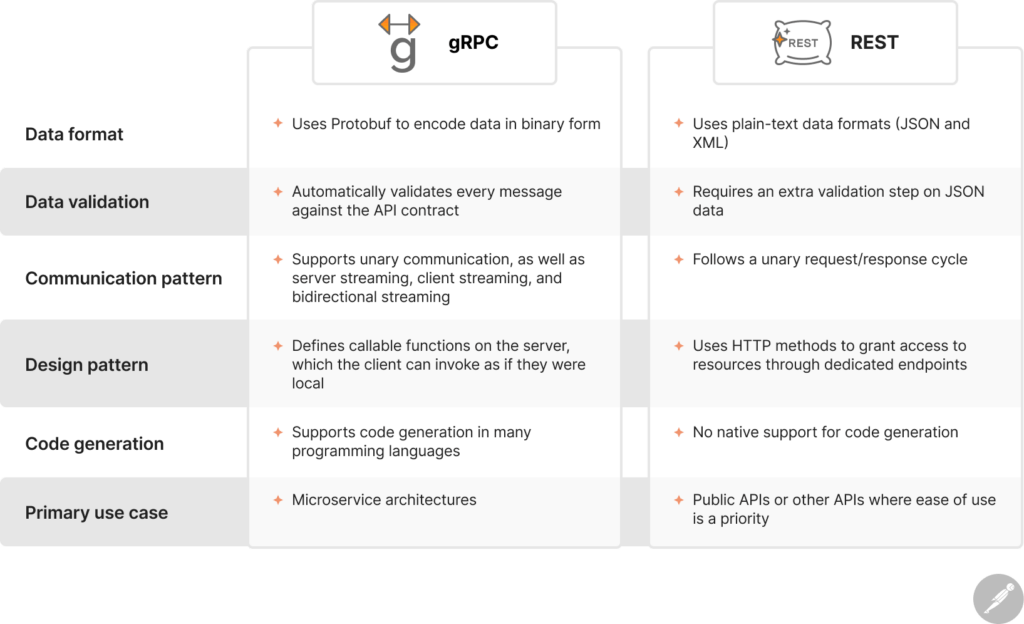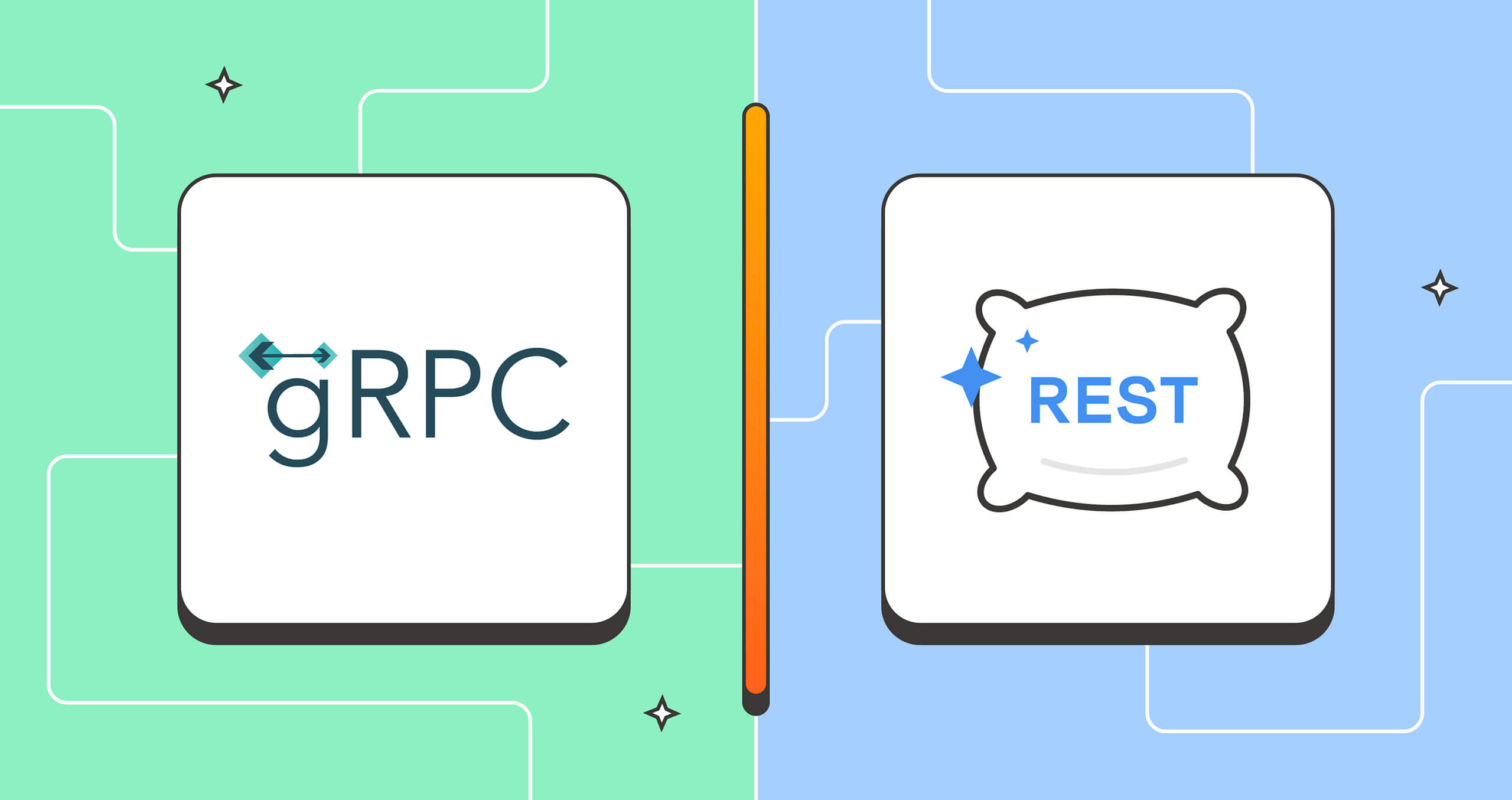gRPC vs. REST
An API is a set of rules and protocols that enable different software components to interact and exchange data. APIs are essential components of all modern applications, and our daily lives would be drastically different without them.
There are many different architectural styles for building APIs, and each one has its own benefits, trade-offs, and ideal use cases. Two of these architectural styles are REST and gRPC. REST defines a set of guidelines for building applications that rely on simplicity, statelessness, and resource-based communication. gRPC, on the other hand, is a high-performance Remote Procedure Call (RPC) framework that utilizes Protocol Buffers and HTTP/2 to enable efficient communication in distributed systems.
REST is the most popular style for building APIs today, but gRPC has seen a surge in adoption due to its support for bidirectional streaming, strong data typing, and language agnostic code generation. But when should you choose one over the other? We’ll answer that question—and more—in this article.
What is REST?
Related: GraphQL vs. REST
REST, which stands for Representational State Transfer, is the most popular architectural style for building APIs. In a RESTful architecture, resources are identified by URIs (Uniform Resource Identifiers), and operations are performed on those resources using a standard set of HTTP methods. Resources are represented in JSON or XML, which is transferred between the client and server in the HTTP request and response bodies.
What is gRPC?
gRPC is an open source, high-performance framework that facilitates efficient communication in distributed systems. gRPC is an implementation of the RPC (Remote Procedure Call) protocol, which enables services to call functions on other machines as if they were local software methods.
gRPC was developed by Google in 2015, and it includes several features that enhance the way remote procedure calls are made. For instance, its use of Protocol Buffers (Protobuf) supports strongly typed service contracts, data serialization, and code generation in a variety of programming languages. It also uses HTTP/2 as its transport protocol, which facilitates bi-directional streaming and reduces latency.
Key similarities: gRPC vs REST
Before we explain the differences between gRPC and REST, let’s first take a look at some of their similarities:
- A client/server architecture: Both gRPC and REST follow the client-server architecture, in which clients send requests and servers respond by returning data or performing actions.
- Use of HTTP: gRPC and REST both use HTTP as their underlying transport protocol. However, REST uses HTTP/1.1, while gRPC uses HTTP/2.
- Support for many programming languages: gRPC and REST are both language agnostic, which means that clients and servers can be implemented in a variety of programming languages.
- Statelessness: Both gRPC and REST are designed to be stateless, which means that every request contains all of the information the server needs to process it. The server therefore does not have to retain any session state.
Key differences: gRPC vs REST

Although gRPC and REST have several foundational similarities, they differ widely in their architectural design, guiding principles, and implementation details. Their main differences are:
Data format
One of the primary differences between gRPC and REST is the data format each one uses. REST typically uses plain-text data formats, such as JSON and XML. These formats are easy to work with and debug, but they are less efficient to transport and parse. gRPC, on the other hand, uses Protobuf to encode data in a binary format. Data that is encoded in a binary form is more space-efficient and faster to serialize and deserialize than text-based formats like JSON or XML, but it is not human-readable.
Data validation
REST and gRPC take different approaches to data validation. With gRPC, developers define a service and message types with Protobuf. This process involves specifying the format and constraints of the data, such as its required fields, supported values, and data types. This definition then serves as the API contract between the client and server, and every message that is transmitted is automatically validated against this contract. REST services, in contrast, must perform an extra validation step on JSON data, which increases processing time.
Communication pattern
gRPC and REST follow different communication patterns. REST relies on a unary request/response cycle, in which a client sends a single request and then waits for a single response from the server. gRPC, in contrast, facilitates unary communication, as well as server streaming (in which a client sends a request and the server sends multiple responses), client streaming (in which the client sends multiple requests and the server returns a single response), and bidirectional streaming (in which both the client and the server can send multiple messages to one another). gRPC is able to support these streaming patterns because it uses HTTP/2 as its transport protocol, which supports multiplexing.
Design pattern
gRPC APIs define callable functions on the server, which the client can then invoke as if it were calling internal functions. This approach is known as service-oriented design. REST APIs, in contrast, have a resource-oriented design, in which clients use a standard set of HTTP methods to access resources through dedicated API endpoints.
Code generation
gRPC’s use of Protobuf supports code generation in multiple programming languages. Developers begin by defining the service, its methods, and data structures in .proto files, which are then processed by Protobuf’s compiler. This process involves generating client and server code in various programming languages. For clients, the generated code typically includes method stubs that correspond to the RPC methods that are defined in the .proto file. These stubs handle serializing data, making the gRPC call over the network, and deserializing the response. For servers, the generated code provides a base class that developers can implement to define the service’s behavior.
Although REST APIs can be developed in a wide range of programming languages, REST does not provide native support for code generation.
When to use gRPC vs. REST
As discussed, gRPC and REST have several distinguishing features that make them well-suited for different use cases.
REST is the most commonly used API architecture today. It’s easier to work with and learn than gRPC, has a robust developer ecosystem, and is compatible with most programming languages and platforms. REST is therefore the ideal choice if you need to create a public API, as developers at other organizations will be able to easily integrate it into their own applications.
gRPC, on the other hand, was designed to support highly efficient, language-agnostic communication in distributed systems. It is therefore better suited than REST for microservice-based architectures, in which individual services may be developed in different programming languages and may face varying workloads. Additionally, gRPC’s use of Protobuf for binary data serialization makes it the better choice for applications that demand low latency and high throughput, while its support for different streaming patterns make it ideal for real-time chat and video applications.

I suggest this article gets updated to include the mentioning of the fully rectified HTTP/3 protocol. This is as the HTTP/3 protocol is now official supported by many mainstream gateways and related infrastructure components, including officially supported by many major public cloud providers (such as AWS and AZURE), for use by both REST and gRPC type of APIs.
Nice article!